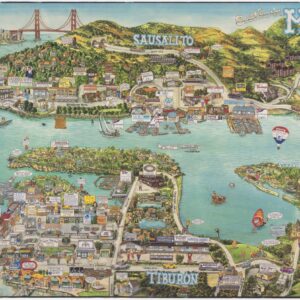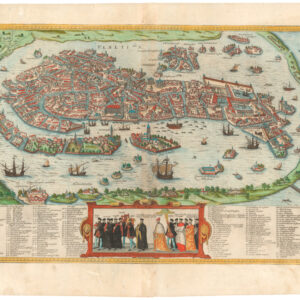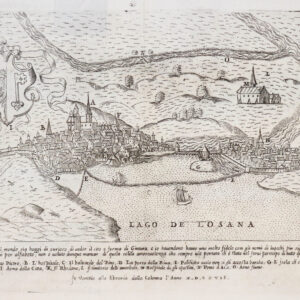A rare and splendid mid-century bird’s-eye-view highlighting maritime infrastructure in the Bay Area.
San Francisco Bay Area Port Facilities.
$900
In stock
Description
This recent discovery is one of the best modern views of San Francisco and the Bay Area we have come across. Commissioned by the CEO of the local non-profit Marine Exchange Inc. in 1954, it provides a stunning birds-eye view of the entire Bay Area, from San Pablo Bay and Petaluma Creek in the north to San Jose in the south.
At the bottom of the view is San Francisco itself. The Golden Gate is also shown, although not the Pacific coast itself. Moving clockwise around the Bay from San Francisco, we note towns and cities like Sausalito, Tiburon, San Rafael, Benicia, Richmond, Berkeley, Oakland, Alameda, and San Leandro. Forming the inland backdrop at the top of the view (east) are Sacramento, Stockton, and Mt Diablo. The focus is clearly on the Bay Area itself, showcasing the commercial vitality and infrastructural capacity of America’s second-largest port facilities on the Pacific coast.
The view was printed in sepia tones, but this has been overprinted with elements in solid black. The black overprinting can essentially be divided into place names and accentuated features. Regarding the first category, terrestrial places – be they core elements such as San Francisco or Oakland – are all rendered in neat single-line lettering that varies in size according to the place’s importance. Marine spaces, such as the Bay itself (and the bays of San Pablo and Suisun), apply thicker lettering emphasized by shadowing.
The more important overprinting is an explicit inclusion of the regional infrastructure (both physical and administrative) that facilitates maritime mobility and trade within the Bay Area. As a membership-based organization, these elements would, of course, be what the Marine Exchange Inc. wished to emphasize in this view. Such features include wharves, quays, and other harbor facilities where goods can be on- or off-loaded, as well as shipping offices and harbor authorities.
These overprinted elements can be identified due to labeling on the view itself. In some cases, the labels are printed directly onto the view, but in most cases, they are simply numbers referring to a rather extensive legend along the bottom. This has been indexed into towns and specific areas, such as the San Francisco piers north and south of the Ferry Building. In many cases, individual piers belong to or are leased by particular companies, all listed in the legend.
In this manner, we are provided a visual capture of the Bay Area in the mid-1950s and an indexed inventory of the companies operating here at that time. The numbered legend is not limited to San Francisco and Oakland, although these take up most of the features. They also include port facilities at the harbors of Richmond, Stockton, and Redwood City. The map highlights a range of interesting features found in the towns and cities directly on the Bay. They include slightly more distant locations such as the general cargo wharves and Yolo Port District’s grain elevator at Sacramento or the Bulk Ore and Deep Sea terminals at Stockton.
Census
Printed in two runs in 1953 and 1954, this view is quite rare. The OCLC lists only four examples in institutional collections throughout the United States. These are at Yale, U.C. Berkeley, the California Historical Society, and the Library of Congress (no. 24517309). Only the U.C. Berkeley and California Historical Society own the 1954 edition. We have not found any examples of this view on the open market.
The view was produced for promotional purposes and distributed free of charge among members and clients. Most original examples would probably have adorned office walls and thus have been discarded once outdated, explaining why so few examples have survived. Other than the date, nothing distinguishes the 1953 and 1954 editions from each other.
Several entities were involved in compiling this view: It was commissioned and printed on behalf of the Marine Exchange Inc., and the actual printing was done by Recorder-Sunset Press in San Francisco. The underlying lithograph, which forms the basis of the view, was designed by Cumberland Studios, as noted in the lower left corner of the printed area. We have yet to be able to locate any other historic or vintage prints from Cumberland Studios – either in institutions or on the open market.
Cartographer(s):
Marine Exchange Inc. is a non-profit membership organization focused on providing maritime services to its members. Such services include collecting, analyzing, and disseminating ship traffic information and facilitating internal communication and debate in the maritime community of northern California. The organization was established in 1849, during the height of the Gold Rush, and is one of the oldest maritime organizations in the country. For a more comprehensive history of the Maritime Exchange Inc., see https://www.sfmx.org/about/our-history/
Recorder-Sunset PressRecorder-Sunset Press was a printing company in San Francisco whose offices and presses were located in the modernist Public Storage Building designed by architect and engineer Will P. Day at 99 South Van Ness Avenue (at Market St and South Van Ness).
From the 1930s onward, Recorder-Sunset Press operated as an alternative name for the older Recorder Printing and Publishing Co. While the multiple names make it difficult to pinpoint the company’s foundation, the Recorder’s first official publication was distributed in 1911 (Proceedings of the First Annual Convention of the California Bar Association, held in Los Angeles, California, December 6 and 7, 1910). It seems both names were used interchangeably for the company until it was finally dissolved in 1986.
Condition Description
Very good. Professionally restored. Some remnants of tape on corners.
References



